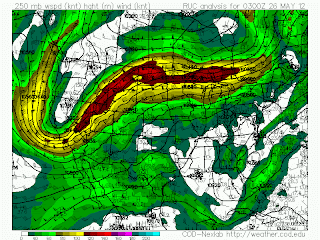The small cluster of convection just southeast of South Carolina was named Tropical Storm Alberto at 21Z on May 19th. RUC analysis indicates that Alberto was just downstream of an upper low and had a temperature at 850 mb of only 12C in the core.
How about this one?
The area of convection just off the coast of The Carolinas was named Subtropical Storm Beryl at 3Z on the May 26th. It appears to be part of an extratropical system, with warm air advection occurring to its south and east. It does have a warm core, but it is still downstream from a broad upper low:At 3Z on June 19, the system south of Newfoundland was named Tropical Storm Chris:
It was at 39.3 latitude at the time it was named. Over the next two days, Chris took on an increasingly tropical appearance.
Sometime after the above satellite image, Chris formed an eye. It was named a hurricane on the 21st at 15Z.
It is not just a question of whether these marginal storms should be named, but also whether such storms would have been named in the past. For climatological purposes, it may be wise to completely ignore tropical storms, and look only at hurricanes. Or perhaps someone could attempt to determine which named storms need to be removed in order to have a consistent record.





















































